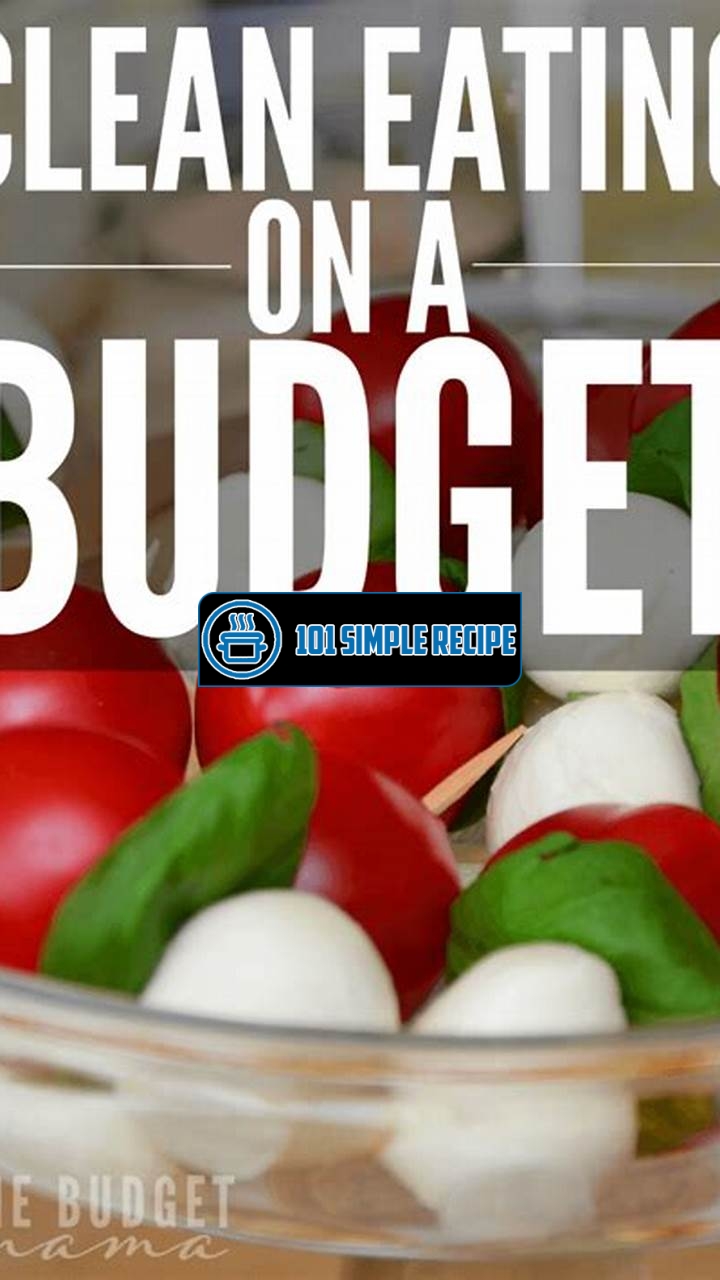In today’s fast-paced world, it can be quite a challenge to eat healthy while still sticking to a tight budget. However, with a little bit of planning and some clever strategies, you can nourish your body with nutritious meals without breaking the bank. In this article, we will explore practical tips and tricks to help you eat healthy on a budget. From shopping smart and finding affordable ingredients to meal prepping and making the most out of leftovers, you’ll discover actionable advice that will make healthy eating a reality for you. So, get ready to embark on a journey towards a healthier you, without compromising your wallet.

The Benefits of Clean Eating on a Budget
Eating healthy is often associated with high costs, but it doesn’t have to be that way. Clean eating on a budget is a practical and achievable goal that can have a significant positive impact on your health and finances. By making smart choices and implementing a few simple strategies, you can enjoy the benefits of clean eating without breaking the bank.
The Health Benefits of Clean Eating
Clean eating focuses on consuming whole, unprocessed foods that are rich in nutrients and free from additives. This approach to nutrition can have a range of health benefits. Firstly, it can help you maintain a healthy weight. By choosing healthy, nutrient-dense foods over processed alternatives, you can support your body’s natural metabolism and reduce the risk of obesity.
Clean eating can also improve your energy levels. Avoiding foods that are high in added sugars and unhealthy fats can prevent spikes and crashes in blood sugar levels, providing you with a steady and sustained release of energy throughout the day.
Additionally, clean eating can boost your immune system. Whole, unprocessed foods are packed with essential vitamins, minerals, and antioxidants that support a strong immune system, reducing the risk of illness and promoting overall well-being.
The Financial Benefits of Clean Eating
Contrary to popular belief, clean eating can actually save you money in the long run. While organic and specialty items may seem expensive, there are plenty of affordable options available. By focusing on budget-friendly foods and avoiding unnecessary processed snacks and packaged meals, you can significantly reduce your grocery bill.
Furthermore, cooking meals from scratch using fresh ingredients is often more cost-effective than relying on convenience foods. By purchasing staple ingredients in bulk and planning your meals ahead, you can make the most of your budget while still enjoying nutritious and delicious meals.
Tips for Making Clean Eating Affordable
- Plan your meals and create a shopping list: This will help you avoid impulse purchases and ensure that you buy only what you need.
- Buy seasonal and local produce: These options are often more affordable and offer a higher nutritional value compared to out-of-season fruits and vegetables.
- Opt for frozen fruits and vegetables: These options are just as nutritious as their fresh counterparts and are often more affordable, especially when certain produce is out of season.
- Choose affordable sources of protein: Incorporate plant-based protein sources such as legumes, lentils, and beans, as they are not only budget-friendly but also provide many health benefits.
- Cook in bulk and freeze leftovers: This allows you to make the most of your ingredients and have ready-to-eat meals on hand when you’re short on time or feeling less motivated to cook.
- Compare prices and look for discounts: Take the time to compare prices at different stores and keep an eye out for promotions and discounts to maximize your savings.
By following these tips, you can embrace clean eating without straining your finances. Remember, the key is to prioritize whole, unprocessed foods that nourish your body and support your overall well-being. With a little planning and creativity, you can enjoy the numerous health benefits of clean eating while staying within your budget.
Eating Whole Foods on a Budget
Are you ready to adopt a clean eating lifestyle but worried about the cost? Don’t fret! Incorporating affordable whole foods into your diet is easier than you think. By understanding what whole foods are, choosing wisely, and meal planning strategically, you’ll be able to eat healthy on a budget without breaking the bank.
Understanding Whole Foods
Before diving into the world of clean eating on a budget, it’s important to have a solid grasp of what whole foods actually are. Put simply, whole foods are minimally processed and free from artificial additives or preservatives. This means they are as close to their natural state as possible, providing you with the maximum nutritional benefits. Examples of whole foods include fruits, vegetables, whole grains, lean proteins, and legumes.
By incorporating these foods into your diet, you’ll be nourishing your body with vitamins, minerals, and fiber while avoiding the unhealthy additives commonly found in processed foods. Eating whole foods can improve your overall health, boost your immune system, and increase your energy levels.
Choosing Affordable Whole Foods
Contrary to popular belief, eating whole foods doesn’t have to drain your wallet. With a little planning and smart shopping, you can make nutritious choices without breaking the bank. Here are some tips to help you choose affordable whole foods:
- Buy in bulk: Purchasing staples like grains, nuts, and seeds in bulk can save you money in the long run. Not only do you get more bang for your buck, but you also reduce packaging waste.
- Shop seasonal produce: Buying fruits and vegetables when they are in season is not only cheaper but also ensures that you’re getting the freshest and most flavorful options available.
- Opt for frozen options: Frozen fruits and vegetables are often more affordable than their fresh counterparts. Plus, they retain their nutrients since they are picked and frozen at their peak ripeness.
- Visit your local farmer’s market: Supporting local farmers not only benefits your community but can also be more cost-effective compared to shopping at big grocery chains. Additionally, by buying directly from farmers, you can ask about any pesticide or herbicide use to make informed choices.
- Don’t ignore store brands: Generic or store-branded whole foods are often just as nutritious as name brands but come at a lower price. Compare labels to ensure you’re getting the same quality.
Meal Planning with Whole Foods
Now that you have a better understanding of whole foods and how to choose affordable options, it’s time to incorporate them into your meal planning. Planning your meals in advance not only helps you stick to a budget but also saves time and reduces food waste. Here’s how to meal plan with whole foods:
- Create a weekly meal plan: Take some time each week to plan your meals and snacks. This will ensure that you have all the necessary ingredients on hand and minimize the chances of ordering takeout. ️
- Batch cook and freeze: Prepare large batches of whole food-based meals and freeze individual portions. This way, you’ll always have a healthy meal available when time is tight or cravings strike.
- Use versatile ingredients: Opt for ingredients that can be used in multiple recipes to make the most of your grocery purchases. For example, buy a whole chicken and use it for a roast one night, then repurpose the leftovers for a stir-fry or soup.
- Get creative with leftovers: Don’t let leftovers go to waste! Transform them into flavorful salads, wraps, or bowls for the next day’s lunch.
- Plan for snacks: Instead of reaching for expensive packaged snacks, prepare your own. Cut up fresh fruits and vegetables, make homemade trail mix, or bake a batch of wholesome muffins to satisfy your snack cravings.
By incorporating these meal planning strategies, you can ensure that you always have healthy and budget-friendly meals at your fingertips. Plus, you’ll be less tempted to splurge on less nutritious options when hunger strikes.
In conclusion, eating whole foods on a budget is entirely possible and can even save you money in the long run. By understanding what whole foods are, choosing affordable options, and meal planning strategically, you can prioritize your health without emptying your wallet. So go ahead and embark on your clean eating journey with confidence!
Cooking Clean on a Budget
When it comes to clean eating on a budget, there are several budget-friendly cooking techniques and recipes that you can try. These techniques will not only help you save money but also ensure that you are eating healthy. Here are some practical tips and tricks:
Essential Cooking Tools for Clean Eating
Having the right cooking tools is essential for clean eating on a budget. Here are some must-have tools that you should consider:
- Vegetable Spiralizer: This handy tool allows you to create noodles out of vegetables like zucchini or sweet potatoes. It’s a great substitute for high-carb pasta and adds variety to your meals.
- Food Processor: A food processor is perfect for making homemade sauces, spreads, and dressings. It can also be used to chop vegetables quickly, saving you time in the kitchen.
- Steamer Basket: Steaming your vegetables is a healthy cooking method that retains their nutrients. Invest in a steamer basket to cook your veggies effortlessly.
- Non-Stick Skillet: A non-stick skillet is a must-have for cooking clean. It requires less oil and makes it easier to cook without added fats.
- Mason Jars: Mason jars are not only great for storage but also for meal prepping. You can prepare salads, overnight oats, and smoothies in advance and store them in these handy jars.
Budget-Friendly Clean Eating Recipes
Preparing your meals at home is a great way to save money and eat clean. Here are some budget-friendly clean eating recipes that you can try:
- Egg Muffins: Whip up a batch of egg muffins by combining beaten eggs with your favorite vegetables and baking them in a muffin tin. These make for a quick and protein-packed breakfast.
- Quinoa Stir-Fry: Cook quinoa and stir-fry it with a medley of colorful vegetables. Add some soy sauce or teriyaki sauce for flavor.
- Chickpea Salad: Combine canned chickpeas with diced vegetables like cucumber, cherry tomatoes, and bell peppers. Toss with a simple dressing made from lemon juice, olive oil, and herbs.
Meal Prep for Clean Eating on a Budget
Meal prepping is an excellent way to stay on track with your clean eating goals without breaking the bank. Here’s how you can meal prep on a budget:
- Plan Your Meals: Sit down and plan your meals for the week, considering ingredients that are budget-friendly and in-season.
- Buy in Bulk: Purchase staple items like rice, quinoa, and lentils in bulk to save money in the long run. These items have a long shelf life and can be used in various recipes.
- Cook in Batches: Prepare large batches of meals and divide them into individual portions. This way, you can grab and go during the week, saving time and money.
- Use Leftovers Creatively: Don’t let leftovers go to waste. Use them creatively to create new meals or repurpose them for lunch the next day.
By following these practical tips and tricks, you can easily embrace clean eating on a budget. Take advantage of budget-friendly cooking techniques and recipes, invest in essential cooking tools, and make meal prepping a part of your routine. With a little planning and creativity, you can enjoy delicious and nutritious meals without breaking the bank.
Shopping Smart for Clean Eating
When it comes to clean eating on a budget, it’s important to shop smart and find affordable ingredients and products. By following these strategies, you can maintain a healthy diet without breaking the bank.
When you step into a grocery store, it can be overwhelming to find clean eating options among the aisles of processed and unhealthy foods. However, with a little guidance, you can navigate the grocery store like a pro.
1. Stick to the Perimeter: The perimeter of the store is usually where you’ll find fresh and unprocessed foods such as fruits, vegetables, lean meats, and dairy products. These are the staples of a clean eating diet.
2. Read Labels: It’s essential to read the labels of packaged foods to ensure they meet your clean eating criteria. Look for products with minimal ingredients, no artificial additives, and low sugar and sodium content. Avoid foods with long lists of unrecognizable ingredients.
3. Buy in Bulk: Purchasing items in bulk can help you save money in the long run. Look for bulk bins where you can buy grains, nuts, and seeds at a lower cost per pound. Just make sure to store them properly to maintain freshness.
4. Prioritize Organic: While organic products may be more expensive, it’s worth investing in them when it comes to certain fruits and vegetables. The Environmental Working Group’s “Dirty Dozen” list highlights the produce with the highest pesticide residue, making it important to prioritize organic options for these items.
Shopping Seasonally and Locally for Clean Eating
One of the best ways to eat clean on a budget is to shop for seasonal and local produce. Here’s why:
- 1. Lower Cost: Seasonal produce is often cheaper because it doesn’t require extensive transportation or storage. It’s abundant during its peak season, making it more affordable for consumers.
- 2. Fresher and Tastier: Seasonal produce is usually harvested at its peak ripeness, ensuring optimal flavor and nutritional value. It’s also more likely to be locally sourced, reducing the time between harvest and your table.
- 3. Support Local Farmers: By purchasing locally grown produce, you are supporting your community’s farmers and economy. It’s a win-win situation for both your health and the local agriculture industry.
Visit farmers’ markets or join a community-supported agriculture (CSA) program to access affordable seasonal and local produce.
Utilizing Discounts and Coupons for Clean Eating
As a budget-conscious clean eater, you can take advantage of discounts and coupons to save money on your grocery bill. Here’s how:
- 1. Subscribe to Store Newsletters: Many grocery stores offer exclusive discounts and coupons to their subscribers. Sign up for their newsletters to receive updates on sales and promotions.
- 2. Use Cashback Apps: Cashback apps like Ibotta and Checkout 51 allow you to earn cashback on select grocery items. Simply scan your receipt or link your store loyalty cards to redeem offers.
- 3. Look for Store Loyalty Programs: Many stores have loyalty programs that offer discounts and rewards to frequent customers. Take advantage of these programs to save money on your clean eating groceries.
- 4. Shop After Peak Hours: Some stores reduce the prices of perishable items towards the end of the day. Shopping during these times can help you find discounted clean eating foods that need to be sold quickly.
By shopping smart, focusing on seasonal produce, and utilizing discounts and coupons, you can successfully eat clean on a budget. Remember to prioritize your health and make conscious choices when it comes to your food. Happy clean eating!
Eating Out on a Clean Eating Budget
When you’re committed to clean eating, dining out can be a challenge. But it doesn’t have to be! With the right strategies, you can enjoy delicious and nutritious meals at restaurants without breaking the bank. In this article, we’ll explore how to eat out on a clean eating budget, including choosing clean eating restaurants, ordering clean meals from regular menus, and tips for sticking to your budget while dining out.
Choosing Clean Eating Restaurants
Not all restaurants are created equal when it comes to clean eating. To ensure you’re making healthy choices while dining out, start by choosing restaurants that prioritize fresh, whole ingredients and offer a variety of clean eating options. Look for places that focus on farm-to-table, organic, or locally sourced ingredients. These types of establishments are more likely to offer menu items that align with your clean eating goals.
Another useful strategy is to check online reviews and ratings to see what others have to say about a restaurant’s commitment to clean eating. Websites and apps like Yelp and TripAdvisor can provide valuable insights from fellow health-conscious diners.
Ordering Clean Meals from Regular Menus
Even if a restaurant doesn’t have a designated clean eating menu, there are still ways to make clean choices from their regular offerings. Start by scanning the menu for dishes that are centered around lean proteins, whole grains, and plenty of vegetables. Avoid menu items that are fried, heavily sauced, or loaded with added sugars.
Don’t be afraid to customize your order to fit your clean eating preferences. Ask for dressings and sauces on the side, opt for steamed or grilled preparations, and request extra vegetables instead of starchy sides. Most restaurants are willing to accommodate special requests and substitutions to meet your dietary needs.
Tips for Sticking to Your Budget while Dining Out
Eating out on a budget doesn’t mean you have to sacrifice your clean eating goals. Here are some practical tips to help you stay on track financially while enjoying a meal at a restaurant:
- Set a budget: Determine how much you’re willing to spend on a meal before heading out. This will help you avoid overspending and make conscious choices.
- Have a snack beforehand: If you’re concerned about portion sizes, have a small, healthy snack before going to the restaurant. This can help curb your appetite and prevent you from ordering more than you need.
- Share with a friend: Consider splitting a meal with a friend or family member. This not only cuts down on costs but also allows you to enjoy a variety of dishes without overeating.
- Drink water: Opt for water instead of sugary beverages or alcohol. Not only is water better for your health, but it’s also free, saving you money.
- Look for deals and specials: Many restaurants offer daily specials or promotions. Keep an eye out for these deals to enjoy clean meals at a discounted price.
By following these tips, you can enjoy clean eating while dining out on a budget, ensuring that your health and financial goals align. Remember, it’s all about making smart choices and prioritizing both your well-being and your wallet.cookie in a mug recipe
Thank you for taking the time to read our article on clean eating on a budget. We hope that you found the information useful and that it has inspired you to make healthier food choices without breaking the bank. Remember, you don’t have to sacrifice your health for your wallet!
If you enjoyed this article and would like to learn more about budget-friendly clean eating tips and recipes, make sure to visit our website again in the future. We will continue to provide you with valuable content to help you achieve your health and financial goals.
Frequently Asked Questions
Here are some frequently asked questions about clean eating on a budget:
| No. | Questions | Answers |
|---|---|---|
| 1. | How can I eat clean on a tight budget? | There are several ways to eat clean on a tight budget. You can start by meal planning and buying in bulk to save money. Additionally, focusing on whole foods such as fruits, vegetables, and grains can be more affordable than processed foods. Don’t forget to check out your local farmer’s market or discount grocery stores for deals on fresh produce. |
| 2. | Are there any cost-effective clean eating protein sources? | Yes, there are plenty of cost-effective clean eating protein sources. Some examples include beans, lentils, eggs, Greek yogurt, and chicken breast. These options provide high-quality protein without breaking the bank. |
| 3. | What are some affordable clean eating snack ideas? | There are many affordable clean eating snack ideas. You can try snacking on fruits and vegetables, homemade granola bars, Greek yogurt with berries, or air-popped popcorn. These snacks are both budget-friendly and nutritious. |
| 4. | How can I avoid food waste while eating clean on a budget? | To avoid food waste, it’s important to plan your meals and only buy what you need. Use leftovers creatively to create new meals, and freeze any excess food for later use. Additionally, learning how to properly store fruits and vegetables can help prolong their freshness. |
| 5. | Is it possible to eat organic on a budget? | Yes, it is possible to eat organic on a budget. Look for organic options at discount grocery stores or consider joining a local CSA (Community Supported Agriculture) program. Buying in bulk and meal planning can also help reduce the cost of organic foods. |
| 6. | Can clean eating on a budget still include indulgences? | Absolutely! Clean eating on a budget doesn’t mean you have to give up all indulgences. You can still enjoy treats in moderation. Look for homemade dessert recipes using natural sweeteners and whole ingredients. The key is to find a balance between nourishing your body and satisfying your cravings. |
Closing Thoughts
Thank you once again for reading our article on clean eating on a budget. We hope that you now feel empowered to make healthier food choices while being mindful of your finances. Remember, a healthy lifestyle is within reach for everyone, and clean eating doesn’t have to be expensive or complicated. We encourage you to explore our website for more tips, recipes, and inspiration. Until next time, happy and budget-friendly cooking!
Jump to Recipe
Clean Eating on a Budget Recipe

Discover how to eat clean on a budget with our delicious and affordable recipe. This dish is packed with nutrient-rich ingredients and won’t break the bank.
- 2 chicken breasts
- 1 cup quinoa
- 1 bell pepper (diced)
- 1 zucchini (sliced)
- 1 onion (chopped)
- 2 cloves garlic (minced)
- 1 tablespoon olive oil
- 1 teaspoon paprika
- 1/2 teaspoon cumin
- Salt and pepper to taste
- Preheat the oven to 375°F.
- In a large bowl, combine the chicken breasts, diced bell pepper, sliced zucchini, chopped onion, minced garlic, olive oil, paprika, cumin, salt, and pepper. Mix well to coat the chicken and vegetables with the spices.
- Transfer the mixture to a baking dish and bake for 45-50 minutes, or until the chicken is cooked through and the vegetables are tender.
- While the chicken is baking, cook the quinoa according to the package instructions.
- Serve the baked chicken and vegetables over the cooked quinoa. Enjoy!






